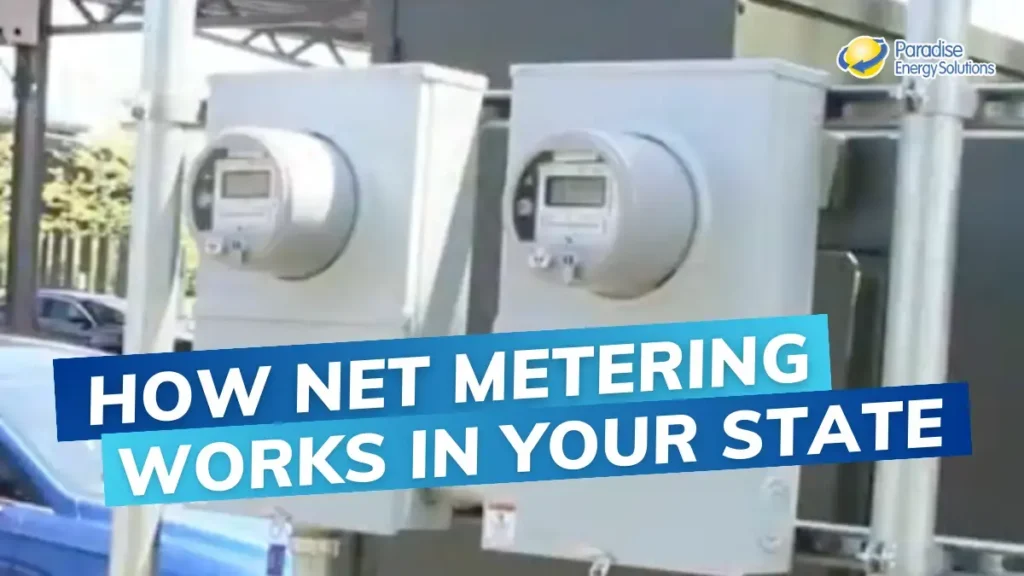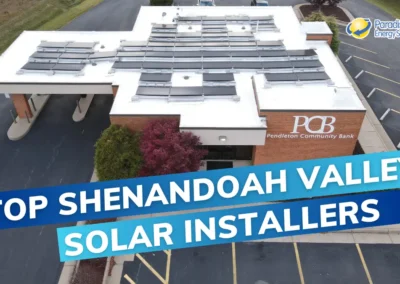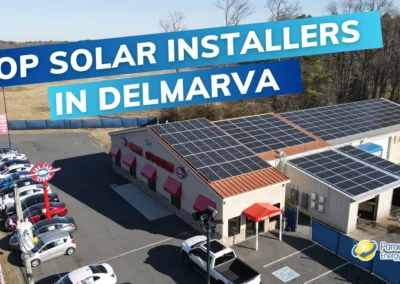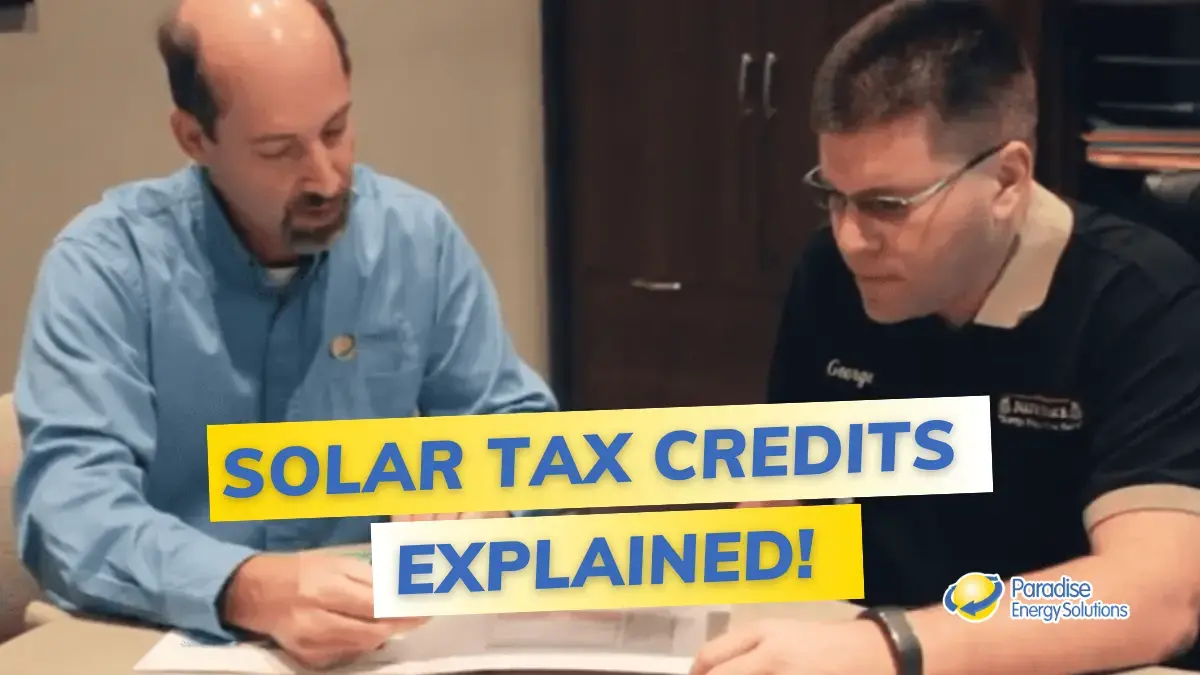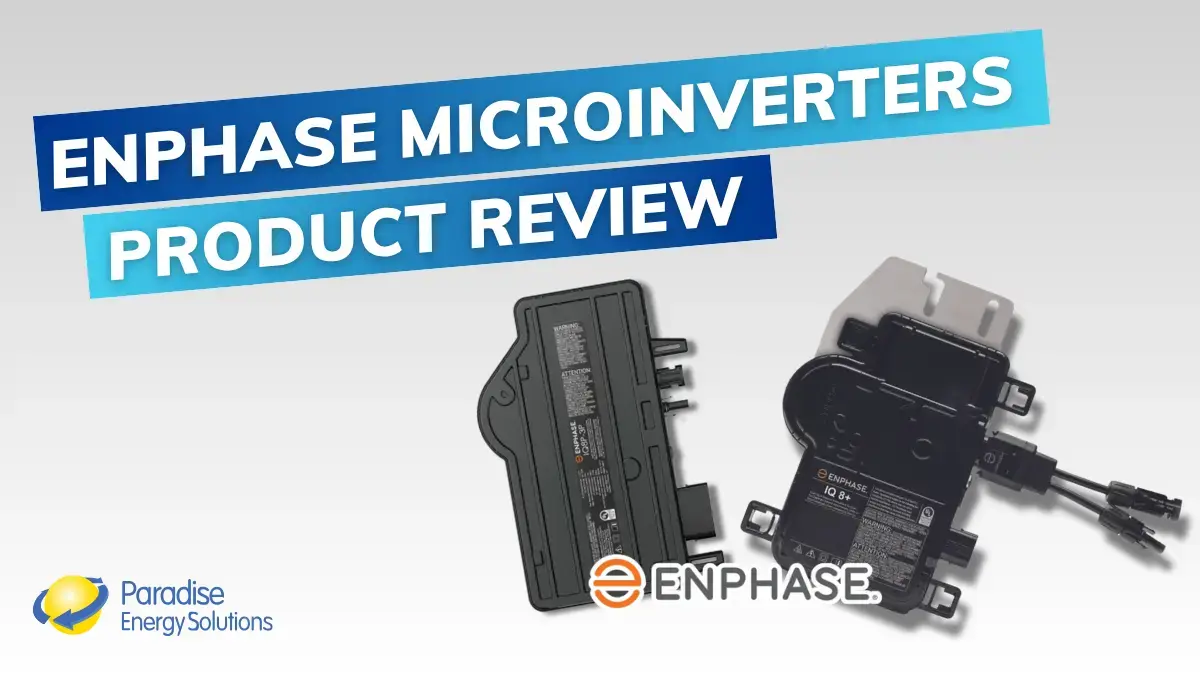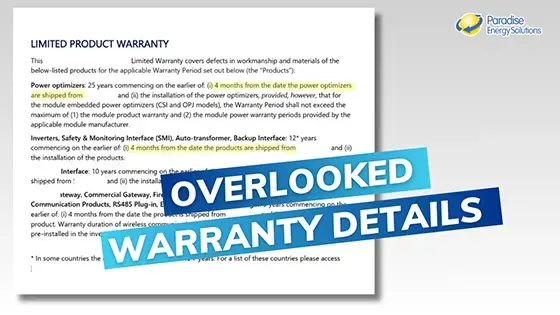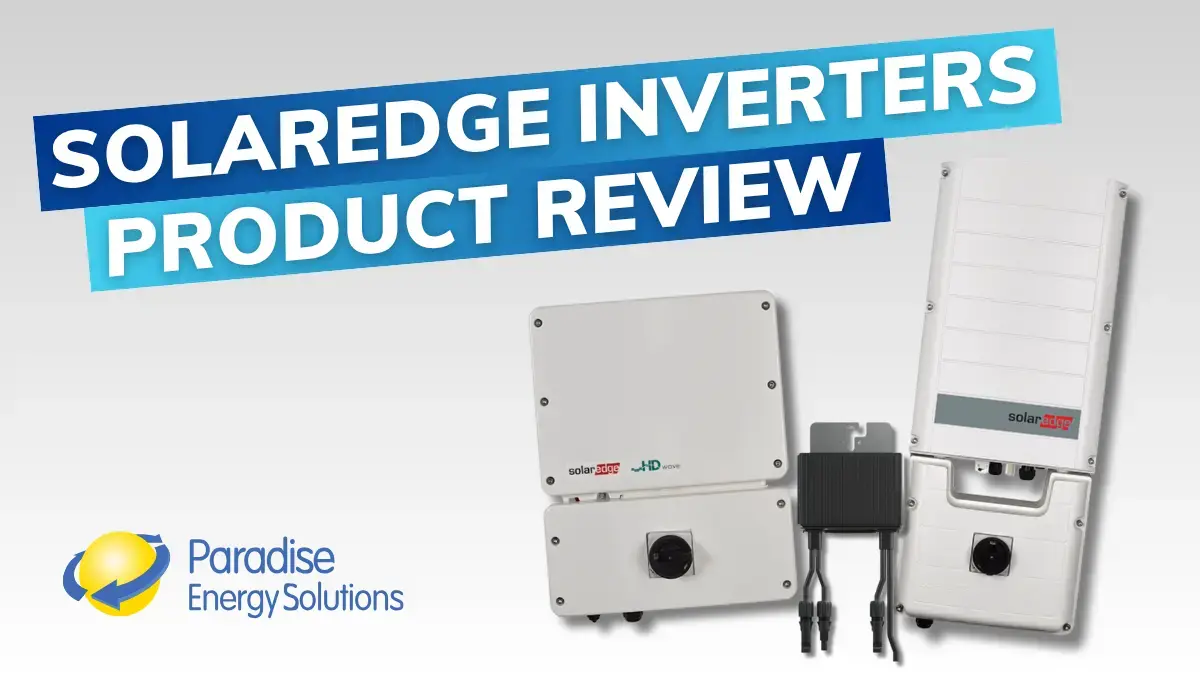Imagine your solar panels cutting down on your electricity bills and rewarding you for the excess energy they produce.
Welcome to the world of net metering—a revolutionary approach by utility companies to make your solar investment even more rewarding.
Rather than selling your surplus solar-generated electricity back to the grid for cash, net metering credits your account with kilowatt-hours (kWh), turning every beam of sunlight into potential savings for future use. This ingenious system allows you to harness the full power of your solar installation, ensuring that every drop of sunlight translates into direct utility bill savings.
Dive deeper into how net metering can transform your relationship with the grid, making you a proactive participant in your energy use and savings.
How Net Metering Works: A Closer Look
Your solar system produces energy on sunny days. Some of that energy is used immediately by your home, farm, or business. However, depending on your electricity usage and your system’s production, it can create more electricity than you use during those sunny hours.
On grid-tied systems, that excess electricity is pushed out through your electricity meter and to the utility grid. In return, the utility will give you a one-for-one credit for the electricity you “uploaded” to the grid.
You’ll draw electricity from the utility company when you use electricity while your solar system is not producing, like at night. Instead of paying for that electricity, you can draw on those credits to “net” out your meter.
What’s so great about it? Net metering typically requires utility companies to credit you with the retail rate for your electricity, which is the rate you pay to buy electricity. This makes it easier to offset more power with solar energy. It essentially uses the electricity grid as a form of free energy storage. That way, you can have access to free electricity generated by your solar system 100% of the time, regardless of how brightly the sun is shining.
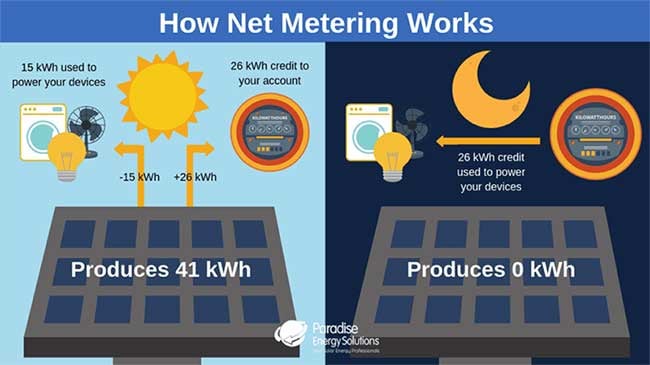
The Benefits of Virtual Net Metering
Also known as meter aggregation, virtual net metering is a program for solar owners with more than one electricity meter within a short distance (usually around 2 miles) of one another.
Virtual net metering allows solar owners to aggregate their net metering credits and apply them to multiple meters. That means if you have more than one meter, you can offset your total electricity usage from all meters with just one solar energy system.
The other solution would be to install a solar system at each meter. However, installing two smaller systems is typically less cost-effective than installing one large system. In most cases, it’ll be less expensive to install one large solar system that can meet the electricity needs of all your meters instead of two systems connected to each meter.
However, not all states and utilities allow virtual net metering.
Navigating Net Metering Policies Across States
While net metering is mandated for public utilities in many states, it’s not the case in all states. Additionally, some electricity co-ops and smaller utilities may not offer net metering, even if you live in a state that has net metering requirements.
System capacity limits, extra credit compensation, and virtual net metering or meter aggregation policies all vary from state to state and from each utility company. Some states, like New York, are slowly phasing out net metering in favor of newer compensation methods.
We’ll take a look at how each state measures up when it comes to compensating you for your solar-generated electricity.
Delaware Net Metering Rules
Delaware requires all its electric utility companies to provide net metering for solar producers. However, there are some limits on the amount of electricity a grid-tied system can produce.
Overall, your solar system’s capacity cannot exceed 110% of your 12-month historical energy consumption. That means if you used 10,000 kilowatt-hours (kWh) of electricity last year, your solar system can only generate 11,000 kWh.
After a year of collecting and using net metering credits, you’ll be able to roll over unused credits to the next year. Your other option is to sell the credits at the avoided-cost rate. Note that the avoided cost rate is less than the one-to-one retail rate associated with net metering.
Delaware utilities also allow for meter aggregation or virtual net metering, which can help if your property has multiple electricity meters. However, you may have to meet some specific criteria to qualify.
Maryland Net Metering Rules
Maryland Net Metering regulations require utility companies and cooperatives to pay all eligible customers with solar energy systems for their system’s production. A system eligible for net metering must be under 2 megawatts (MW) in capacity or 200% of the owner’s annual electricity usage.
Maryland’s Net Metering regulations mandate that utility companies and cooperatives compensate all eligible customers who have solar energy systems for the energy their system generates. To qualify for net metering, a system must have a capacity of under 2 megawatts (MW) or be equivalent to 200% of the owner’s annual electricity usage.
The reimbursement procedures for net metering can vary depending on the utility company. While some Maryland utilities opt to reimburse customers at the end of the year, others choose to roll over credits for the next anniversary cycle instead of providing a payout.
Furthermore, aggregate net metering is an option available for commercial entities, agricultural producers, non-profit organizations, and municipalities. This feature enables a single solar system to offset multiple electricity meters virtually.
The specific requirements for aggregate net metering will differ by utility company. For instance, Delmarva Power mandates one host account and a minimum of two waterfall/child accounts for aggregation, while Choptank Electric and Easton Utilities only require one host account and one waterfall/child account.
New Jersey Net Metering Rules
New Jersey requires all their utilities to comply with net metering. That means they’ll compensate solar owners for excess electricity uploaded to the grid at the one-to-one retail rate.
However, to connect your system to the grid and benefit from net metering, its annual production cannot exceed 100% of your annual electricity usage.
If you have excess credits at the end of an annualized period, you’ll be compensated at the wholesale electricity rate, which is less than the retail price reflected in your net metering credits.
New Jersey only allows meter aggregation or virtual net metering for solar systems that offset electricity for public entities, like state and local governments, local agencies, and school districts.
New York Net Metering Rules
New York previously required utilities to provide net metering to all homes and businesses with a grid-tied solar system. However, they began transitioning into a new compensation plan in recent years. Known as the VDER Value Stack, it recognizes that solar-generated electricity’s value differs from traditional utility electricity.
If the VDER value stack is your compensation method, you won’t be credited with the retail rate of electricity as you would with net metering. Instead, you’ll be credited at the Value Stack Tariff rate.
This variable rate increases and decreases based on various factors, including the time the electricity is produced, where the electricity is produced, and how much other solar energy is being produced in that area at that time.
For many residential customers, this rate tends to be lower than what it would be with net metering. For many commercial customers, the VDER value stack rate can be higher than the retail rate.
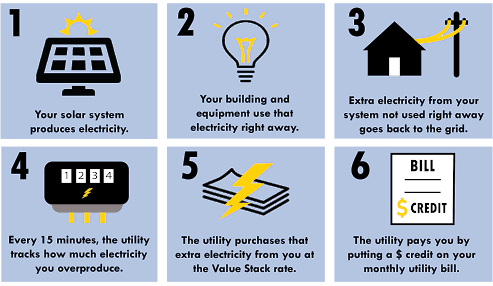
Until 2022, residential solar owners can choose between net metering and the VDER Value Stack Tariff. Large commercial systems, however, will have to use the Value Stack program.
After 2022, New York solar owners can still opt for net metering. However, they’ll have to pay a Customer Benefits Charge (CBC). This is to ensure that solar owners help to pay part of the loss incurred by the utility because of net metering instead of placing the entire financial burden on those who do not own solar.
Excess credits for non-residential solar producers can be carried over indefinitely for solar owners who are grandfathered into net metering. Excess credits from residential producers will be compensated based on the generation rate, which is less than the retail rate associated with the net metering credit.
All that said, the VDER Value Stack Tariff compensation method or the CBC will not significantly impact the financial return of solar investments in New York.
Solar generating capacity is capped at 25 kW for residential, 100 kW for farmers, and 2 MW for non-residential.
Meter aggregation or virtual net metering is allowed for non-residential or agricultural systems, assuming they meet the specific requirements.
Ohio Net Metering Rules
Public utility companies in Ohio are required to offer a form of net metering to their customers who generate solar electricity. However, most public utilities will not credit any overproduction from solar in the course of a month at the retail rate but rather at the wholesale rate. That means that for each excess kWh generated by solar energy, the system owners will not receive a credit one-for-one to draw off the grid. This is known as Net Billing.
Any solar system that produces more than 100% of a customer’s load in the course of a year will be liable to lose net metering status altogether. For this reason, a solar system should be sized at no more than 95% of a customer’s annual usage.
Many utility Cooperatives in Ohio offer no form of net metering, making it difficult for some customers to realize the benefits of solar.
Ohio net metering regulations do not address virtual net metering or meter aggregation, meaning this will vary from case to case and from utility to utility.
Pennsylvania Net Metering Rules
Pennsylvania requires its utility companies to offer net metering to the owners of solar systems. That means excess electricity produced by a grid-tied system will be compensated by a credit equal to the retail rate for that amount of electricity.
Pennsylvania sets a cap for grid-tied systems, though it varies depending on the type of system installed. Residential solar systems cannot exceed 50 kW. Non-residential systems cannot exceed 3 megawatts (MW). Microgrid and emergency systems are capped at 5 MW.
Should you end up with additional credits, you can roll them over from month to month. However, after the year-end (which typically is June), depending on your Utility, you may be compensated for remaining credits at the wholesale rate or the retail rate Some Utilities such as PPL will even pay you in the form of a check for excess kWh generated over the course of a year and pays the “price to compare” on your PPL electric statement.
Pennsylvania does allow virtual net metering and meter aggregation, meaning if you have more than one electricity meter, you can reap the benefits of net metering even if you only have one solar system connected to one of your meters. To virtual net meter, the properties must be in the same utility grid zone and within 2 miles of each other, and the billing account must be in the same name.
Virginia Net Metering Rules
Virginia currently mandates that utility companies offer solar owners net metering. However, this policy is expected to change, and net metering could eventually be eliminated. If you’re a current or future solar panel owner in Virginia, it’s crucial to understand these potential changes and act quickly.
Currently, grid-tied solar energy systems receive credit at the retail rate for excess generation, allowing businesses, farms, and homes to offset their electricity bills. However, Virginia does not compensate solar owners for excess production on a yearly basis. Instead, credits roll over month to month, but any unused credits at the end of the year are lost.
Upcoming proposals from utilities like Appalachian Power and Dominion could make net metering less favorable, with changes potentially rolling out between 2025 and 2026. Solar owners are advised to act quickly to be grandfathered under the current system before these adjustments take place.
System Capacity Limits
To connect to the grid and qualify for net metering, solar systems must comply with Virginia’s system size limits:
- Residential systems cannot exceed 20 kW.
- Non-residential systems are limited to 1,000 kW (1 MW).
- Agricultural systems max out at 500 kW.
- Solar panel systems cannot exceed 100% of a customer’s annual electricity usage.
What Happens to Excess Credits?
Currently, there are two options for excess net metering credits:
- Roll credits over indefinitely to future billing cycles.
- Opt for a payout, but the compensation rate is at the avoided cost rate (lower than retail rates).
Under the upcoming changes, this compensation structure may change or disappear. Historically, utilities have reduced or removed net metering credits when revising their programs.
West Virginia Net Metering Rule
West Virginia requires its utility companies to offer net energy metering to solar systems located in the state. That means if your grid-tied solar energy system produces excess electricity and uploads it to the grid, you’ll receive credit. That credit will be equal to the retail cost of electricity, so you can substitute it one-for-one for any electricity you need to draw from the grid.
For your solar system to be eligible, it must comply with West Virginia’s system capacity limits, which vary with customer type and utility.
All residential systems are limited to 25 kW in capacity. For commercial solar systems connected to an investor-owned utility (IOU) that has more than 30,000 customers, their system is limited to 500 kW. Industrial systems connected to IOUs with over 30,000 customers can have a capacity of up to 2 MW.
If the commercial or industrial solar system is connected to an IOU with fewer than 30,000 customers, the limit is 50 kW.
Excess credits can roll over from one monthly billing period to the next. However, there is no annual rollover, and credits cannot be sold, even for the lesser generation rate.
Virtual net metering and meter aggregation is allowed in West Virginia, allowing solar owners with multiple electricity meters to offset their electrical needs with just one solar system.
The Future of Net Metering and What It Means for You
The regulatory outlook for net metering remains positive, as states are doing all they can to encourage residents and businesses to switch to renewable energy. However, as we’ve seen with New York, states are adjusting it to ensure non-solar owners aren’t paying more to offset the costs.
In short, just because net metering is a policy now doesn’t mean that will always be the case.
Should your state do away with net metering, history suggests you’ll likely be grandfathered into the policy. As long as you install your solar system while net metering is a policy, that should stay true for your system for its entire life. However, we can not 100% guarantee that will be the case.
This is just one of several reasons why you shouldn’t wait to go solar. Install your system while net metering is a policy in your state, and take advantage of it for the decades-long lifespan of your solar system.
Are you ready to learn more about solar energy? Sign up below for our Solar Made Easy video series. You’ll get 15 short educational videos sent directly to your inbox.
